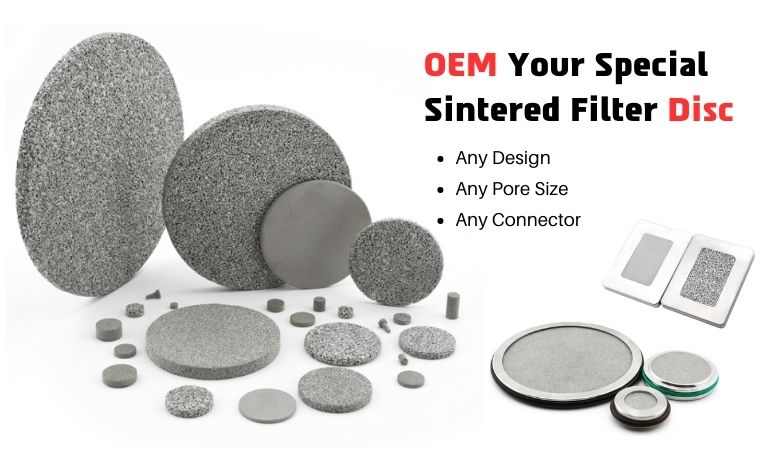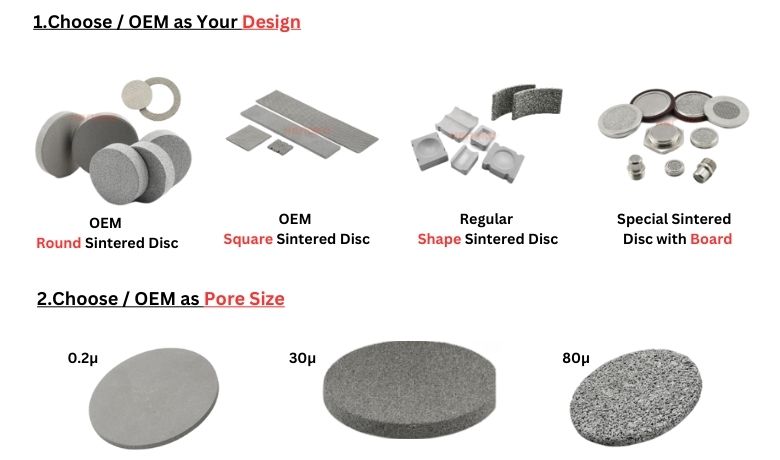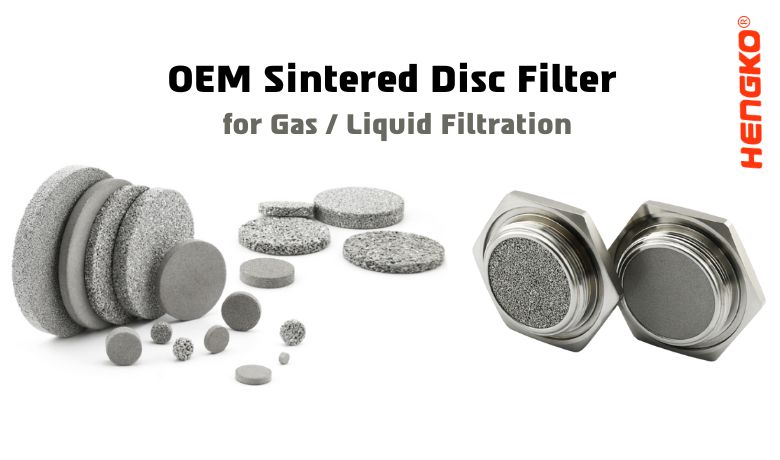
1. What is sintered filter disc ?
A sintered filter disc is a filtration device made from sintered materials. Here's a detailed breakdown:
1. Sintering:
Sintering is a process in which powdered material is exposed to heat below its melting point to cause the particles to bond together, forming a solid mass. This method is often used with metals, ceramics, and other materials to form dense structures with specific properties.
2. Filter Disc:
This refers to the shape and primary function of the product. In the context of a sintered filter disc, it's a disc-shaped object designed to allow the passage of fluids (liquids or gases) through it, while retaining or filtering out solid particles or contaminants.
3. Characteristics and Advantages:
* High Strength:
Due to the sintering process, these discs have a strong mechanical structure.
* Uniform Pore Size:
The disc has a consistent pore size throughout, which provides precise filtration capabilities.
* Heat & Corrosion Resistance:
Depending on the material used, sintered discs can be resistant to high temperatures and corrosive environments.
* Reusable:
These filter discs can be cleaned and reused multiple times.
* Versatility:
Sintered filter discs can be made from various materials like stainless steel, bronze, titanium, and more, depending on the specific requirements of the application.
4. Applications:
Sintered filter discs are often used in industries like petroleum, chemical, food and beverage, and pharmaceuticals. They can also be found in applications like water treatment, gas distribution, and air purification.
In summary, a sintered filter disc is a solid and porous disc created by heating powdered material below its melting point to bond the particles together, which is then used to filter fluids while offering high strength, uniform filtration, and resistance to various conditions.
2. History of filter ?
The history of filtration spans many centuries and civilizations, and it's a testament to humanity's constant endeavor to access clean water and air, among other things. Here's a brief history of filters:
1. Ancient Civilizations:
* Ancient Egypt:
Ancient Egyptians were known to use alum to purify drinking water. They would also use cloth and sand as basic filters to strain out impurities.
* Ancient Greece:
Hippocrates, the renowned Greek physician, designed the "Hippocratic sleeve" – a cloth bag to purify water by removing its sediment and foul taste.
2. Middle Ages:
* In various regions, sand and gravel filtration was employed. One notable example is the use of slow sand filters in 19th-century London, which significantly reduced cholera outbreaks.
3. Industrial Revolution:
* The 19th century saw rapid industrialization, which led to increased water pollution. As a response, more advanced filtration techniques were developed.
* In 1804, the first large-scale municipal water treatment plant using slow sand filters was built in Scotland.
* By the late 19th century, rapid sand filters, which use a much faster flow rate than slow sand filters, were developed. Chemicals like chlorine were also introduced for disinfection around this time.
4. 20th Century:
* Filtration for Air Quality:
With the advent of air conditioning systems, there was a need to ensure indoor air quality. This led to the development of air filters that could remove dust and pollutants.
* HEPA Filters:
Developed during World War II, High Efficiency Particulate Air (HEPA) filters were initially designed to prevent the spread of radioactive particles in atomic research labs. Today, they're widely used in medical facilities, homes, and various industries.
* Membrane Filtration:
Technological advancements led to the creation of membranes that could filter out incredibly tiny particles, leading to applications like reverse osmosis for water purification.
5. 21st Century:
* Nanofiltration and Biofiltration:
With advances in nanotechnology, filters at the nanoscale are being researched and implemented. Additionally, biological filters using bacteria and plants are also gaining traction in some wastewater treatment scenarios.
* Smart Filters:
With the rise of IoT (Internet of Things) and advanced materials, "smart" filters that can indicate when they need changing, or that adapt to different pollutants, are being developed.
Throughout history, the fundamental concept of filtration has remained the same: passing a fluid (liquid or gas) through a medium to remove unwanted particles. However, with technological and scientific advancements, the efficiency and application of filters have broadened immensely. From the basic cloth and sand filters of ancient civilizations to the advanced nano filters of today, filtration has been an essential tool for ensuring health, safety, and environmental protection.
3. Why use sintered filter disc?
Using a sintered filter disc offers multiple advantages, making it suitable for various applications across different industries. Here are the primary reasons for using a sintered filter disc:
1. High Mechanical Strength:
* The sintering process results in a filter disc with a strong mechanical structure. This strength allows the disc to withstand high pressures and stresses without deforming or breaking.
2. Uniform Pore Size:
* Sintered filter discs provide consistent and precise filtration because of their uniform pore size distribution. This ensures reliable and predictable filtration performance.
3. Heat and Corrosion Resistance:
* Depending on the material used (e.g., stainless steel, titanium), sintered discs can resist high temperatures and corrosive environments. This makes them ideal for applications where temperature and chemical stability are crucial.
4. Long Service Life and Reusability:
* Sintered filter discs are durable and can be cleaned and reused multiple times, reducing replacement costs and minimizing waste.
5. Versatility:
* They can be produced from a variety of materials based on the specific application requirements. Common materials include stainless steel, bronze, and titanium, among others.
* This versatility allows them to be used in a wide range of environments and for different filtration needs.
6. Backwashable:
* Many sintered filter discs can be backwashed (cleaned by reversing the flow of fluid) to remove accumulated particles, extending the filter's service life and maintaining its performance.
7. Defined Porosity and Filtration Precision:
* The controlled production process allows for specific porosity levels, enabling filtration to a defined particle size.
8. Low Maintenance:
* Their durability and ability to be cleaned mean that sintered filter discs often require less frequent maintenance and replacement than some other filtration media.
9. Broad Application Range:
* Their characteristics make them suitable for a wide range of applications, from food and beverage processing to petrochemicals, pharmaceuticals, and more.
- In conclusion, sintered filter discs are favored in many industries because of their strength, precision, versatility, and durability. They offer reliable and efficient filtration solutions in environments where other filtration media might fail or not provide the desired performance.

4. Types of sintered disc filter ?
Sintered disc filters come in a variety of types based on the materials used, the manufacturing process, and their specific applications. The following are the main types of sintered disc filters:
1. Based on Material:
* Sintered Stainless Steel Disc Filters: These are among the most common and are known for their corrosion resistance and durability. They're widely used in food and beverage, pharmaceutical, and chemical industries.
* Sintered Bronze Disc Filters: These have good thermal conductivity and corrosion resistance. They're often used in pneumatic applications.
* Sintered Titanium Disc Filters: Known for their superior strength and corrosion resistance, especially in saltwater or chlorine-rich environments.
* Sintered Ceramic Disc Filters: Used in high-temperature applications and offer excellent chemical resistance.
* Sintered Polyethylene (PE) and Polypropylene (PP) Disc Filters: Used in some specific chemical processes and where plastic materials are preferred.
2. Based on Layering:
Monolayer Sintered Disc Filters: Made from a single layer of sintered material.
Multilayer Sintered Disc Filters: These are constructed from multiple layers of sintered materials, which can allow for more complex filtration processes, capturing different sized particles in different layers.
3. Based on Pore Size:
Micro-pore Sintered Disc Filters: Have very fine pores and are used for filtering tiny particles.
Macro-pore Sintered Disc Filters: Have larger pores and are used for coarser filtration processes.
4. Based on Process:
Non-woven Metal Fiber Sintered Disc: Made by sintering metal fibers into a porous structure, often resulting in a high porosity and permeability filter.
Mesh Laminated Sintered Disc Filters: Made by laminating multiple layers of woven mesh together and then sintering them. This provides enhanced strength and specific filtration characteristics.
5. Based on Application:
Fluidization Sintered Disc Filters: These are designed specifically for fluidized beds in processes that require the uniform distribution of gases through powders or granular materials.
Sparger Sintered Disc Filters: Used to introduce gases into liquids, creating fine bubbles for processes like aeration or fermentation.
6. Based on Shape and Construction:
Flat Sintered Disc Filters: These are flat discs, commonly used in many standard filtration applications.
Pleated Sintered Disc Filters: These have a pleated construction to increase the surface area and, therefore, the filtration capacity.
In selecting the appropriate type of sintered disc filter, considerations like the nature of the material to be filtered, the desired purity level, operating environment (temperature, pressure, and chemicals present), and specific application requirements all play a role. Manufacturers typically provide detailed specifications and can guide users to the best choice for their needs.
5. Why use Metal for Filter? Metal Materials Choice for Filter ?
Using metal for filters offers several benefits, especially when compared to other materials such as fabric, paper, or some plastics. Here's why metal is often the material of choice for filters:
Advantages of Using Metal for Filters:
1. Durability: Metals, especially when sintered, can withstand high pressures without undergoing deformation or rupture. This makes them suitable for demanding environments where strength is paramount.
2. Temperature Resistance: Metals can operate effectively at higher temperatures without degrading or melting, unlike plastic-based filters.
3. Corrosion Resistance: Certain metals, especially when alloyed, can resist corrosion from chemicals, making them ideal for use in chemically aggressive environments.
4. Cleanability & Reusability: Metal filters can often be cleaned (even backwashed) and reused, leading to longer service lives and reduced replacement costs.
5. Defined Pore Structure: Sintered metal filters offer a precise and consistent pore structure, ensuring consistent filtration performance.
6. High Flow Rates: Metal filters often allow for higher flow rates due to their structural integrity and defined porosity.
Common Metal Materials Used for Filters:
1. Stainless Steel: This is perhaps the most widely used metal for filters. It offers a good balance of corrosion resistance, temperature resistance, and strength. Different grades of stainless steel (e.g., 304, 316) are used based on specific application requirements.
2. Bronze: This alloy of copper and tin offers good corrosion resistance and is often used in pneumatic applications and for certain chemical processes.
3. Titanium: Known for its superior strength-to-weight ratio and excellent corrosion resistance, especially in saltwater or chlorine-rich environments.
4. Nickel Alloys: Materials like Monel or Inconel are used in environments where exceptional resistance to heat and corrosion is required.
5 Aluminum: Lightweight and corrosion-resistant, aluminum filters are often used in applications where weight is a concern.
6. Tantalum: This metal is extremely resistant to corrosion and is used in some highly specialized applications, especially in aggressive chemical environments.
7. Hastelloy: An alloy that can resist corrosion from a wide range of chemicals, making it suitable for challenging environments.
8. Zinc: Often used in galvanizing processes to coat steel and prevent rust, zinc is also used in some filter applications for its specific properties.
When selecting a metal material for a filter, it's crucial to consider the specific conditions under which the filter will operate, such as temperature, pressure, and the nature of the chemicals involved. The correct choice ensures the filter's longevity, efficiency, and overall performance in the intended application.

6. What factor you should care when choose right metal filter for your filtration project ?
Choosing the right metal filter for your filtration project is essential for effective performance, longevity, and cost-efficiency. Here are the factors to consider when selecting a metal filter:
1. Filtration Precision:
Determine the particle size you wish to filter out. This will help you choose a filter with the appropriate pore size and structure.
2. Operating Temperature:
Different metals have different temperature tolerances. Ensure the metal you choose can handle the temperature of the fluid or gas you're filtering.
3. Corrosion Resistance:
Depending on the chemical composition of the fluid or gas, some metals might corrode faster than others. Choose a metal that's resistant to corrosion in your specific application.
4. Pressure Conditions:
The filter should be able to withstand the operating pressure, especially if you're dealing with high-pressure systems.
5. Flow Rate:
Consider the desired flow rate for your system. The filter's porosity, thickness, and size will influence this.
6. Cleanability and Maintenance:
Some metal filters can be cleaned and reused. Depending on your application, you might prefer a filter that's easy to clean or one that can be used for extended periods without maintenance.
7. Mechanical Strength:
If the filter is going to be subjected to mechanical stresses (like vibrations), it should have adequate strength to endure without failing.
8. Cost:
While it's important to choose a filter that meets your needs, it's also essential to consider your budget. However, it's worth noting that going for the cheapest option isn't always cost-effective in the long run, especially if it means sacrificing on performance or lifespan.
9. Compatibility:
Ensure the metal filter is chemically compatible with the fluids or gases it will come into contact with. This is crucial to prevent unwanted reactions and to ensure the safety and longevity of the filter.
10. Lifespan:
Depending on the frequency of use and operating conditions, you'll want to consider how long the filter is expected to last before needing replacement.
11. Regulatory and Quality Standards:
If you're working in industries like food and beverages, pharmaceuticals, or certain chemical processes, there might be specific regulatory and quality standards the filters need to meet.
12. Environmental Conditions:
Consider external factors like exposure to saltwater (in marine environments) or other corrosive atmospheres which might affect the filter's material.
13. Filter Format and Size:
Depending on your system's design, you'll need to consider the filter's shape, size, and format. For instance, whether you need discs, sheets, or cylindrical filters.
14. Ease of Installation:
Consider how easy it is to install and replace the filter in your system.
When selecting a metal filter, it's often beneficial to consult with the manufacturer or a filtration expert. They can provide guidance tailored to your specific requirements and conditions.
7. What parameters you should supply when OEM sintered filter disc in sintered filter manufacturer ?
When working with an original equipment manufacturer (OEM) to produce sintered filter discs, you need to provide specific parameters to ensure that the final product aligns with your requirements. Here are the key parameters and details you should supply:
1. Material Type:
Specify the type of metal or alloy you need, such as stainless steel (e.g., SS 304, SS 316), bronze, titanium, or others.
2. Diameter and Thickness:
Provide the exact diameter and thickness of the disc filters required.
3. Pore Size & Porosity:
Indicate the desired pore size or range of pore sizes. This directly affects the filtration precision.
If you have specific requirements, also mention the porosity percentage.
4. Filtration Precision:
Define the smallest particle size that the filter should retain.
5. Flow Rate:
If you have specific requirements for the flow rate, provide these specifications.
6. Operating Conditions:
Mention expected operating temperatures, pressures, and any chemical exposures.
7. Shape & Structure:
While disc is the primary shape of interest, specify any unique shape variations or features. Also, mention if it should be flat, pleated, or have any other specific structural attributes.
8. Edge Treatment:
Specify if you need any special treatments on the edges, such as welding, sealing, or reinforcement.
9. Layering:
Indicate if the disc should be monolayer, multilayer, or laminated with other materials.
10. Quantity:
Mention the number of filter discs you require, both for the immediate order and potential future orders.
11. Application & Use:
Briefly describe the primary application of the filter disc. This helps the manufacturer understand the context and might influence recommendations.
12. Standards & Compliance:
If the filter discs need to meet specific industry or regulatory standards, provide these details.
13. Preferred Packaging:
Indicate if you have specific packaging needs for shipping, storage, or both.
14. Delivery Timeline:
Provide desired lead times or specific deadlines for the production and delivery of the filter discs.
15. Additional Customizations:
If you have other customization requirements or specific features not covered above, ensure to include them.
16. Any Previous Samples or Prototypes:
If you've had previous versions or prototypes of the filter disc made, providing samples or detailed specifications can be beneficial.
It's always a good practice to maintain open communication with the OEM and be ready to clarify or provide additional details when necessary. Working closely with the manufacturer will ensure that the final product aligns closely with your needs and expectations.
Contact Us
Looking for the perfect sintered disc filter tailored to your filtration system?
Don't compromise on quality or precision!
Contact HENGKO now and let our experts craft the ideal solution for your unique requirements.
OEM your sintered disc filter with us.
Reach out directly to ka@hengko.com and kick-start your project today!
Post time: Oct-05-2023




